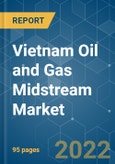Vietnam's oil and gas midstream market is expected to record a CAGR of more than 5.57% during the forecast period (2022-2027). The oil and gas midstream market in Vietnam was unaffected by the COVID-19 outbreak. The constant usage of storage facilities for storing hydrocarbons, usage of pipelines for fuel transportation, and resilient demand for LNG in 2020 kept the demand for midstream services normalized. Factors such as increasing demand for natural gas and oil and increasing gas production in the country are expected to boost Vietnam's oil and gas midstream market during the forecast period. However, oil production is decreasing in the country, which is expected to impede the market’s growth.
The Vietnamese oil and gas midstream market is consolidated. The major companies include Vietnam National Petroleum Group, Vietnam Oil and Gas Group, Vietsovpetro, PJSC Rosneft Oil Company, and Perenco SA.
This product will be delivered within 2 business days.
Key Highlights
- Vietnam is increasing its storage capacity, with the Vietnam Master Plan pushing for an increase in energy security. However, renewables have impeded growth in the sector as a reliable alternative to oil and gas.
- New offshore natural gas and condensate recovery in the block was made by foreign companies in the exclusive economic zone of Vietnam in the South China Sea, which, if economically viable, can boost the oil and gas midstream sector.
- Increasing investments in Vietnam’s midstream industry is driving the market by increasing the capacity of oil and gas transportation.
Key Market Trends
Storage Capacity to Witness Significant Growth
- Vietnam aims to develop its oil-stockpiling system to stabilize its domestic oil consuming market and the productive capacity of its oil refineries, enhance energy security, and keep up with the development of the domestic oil market as the country anticipates rising demand for domestic oil and dependence on imports of crude oil and petroleum products.
- The Vietnamese government is pushing for storage tanks to be made by the government and privately-owned oil companies as they are obliged to maintain a volume of reserve amounting to at least 30 days’ worth of net imports. The oil stockpiling in the country is expected to be around 5.9 million ton and is expected to increase further during the forecast period.
- In January 2022, Japan Petroleum Exploration (Japex) signed a share purchase agreement with Vietnam’s ITECO to promote the construction of the Northern Vietnam LNG Terminal in Hai Phong. The project's initial development includes the construction of a 50,000 cubic meter LNG storage tank and associated jetty facilities capable of handling up to 650,000 ton of LNG per annum. The project is expected to get commissioned by 2025.
- In September 2021, PetroVietnam Gas signed an agreement with AES Corp. to form a joint venture to operate Son My LNG terminal in Vietnam. The project has an investment cost of USD 1.3 billion and is located in the central province of Binh Thuan. The project supplies 3.6 million tons of LNG to two power plants and is expected to be commissioned by 2026.
- Hence, storage capacity is expected to increase slightly during the forecast period due to increased consumption and investment.
Increasing Investments to Drive the Market
- The mid-stream sector plays a crucial role in transporting and storing natural gas, crude oil, and petroleum products over a long distance from the place of production. Due to increasing investments, the oil and gas midstream sector is witnessing significant growth in Vietnam.
- Natural gas production increased by 6.10% in the region in 2020, to 8.7 billion cubic meters, from 8.2 bcm in 2011, and crude oil production reached around 207 thousand barrels per day. Increasing production of natural gas and crude oil requires better infrastructure such as fabricated tanks and crude oil stockpiles to support the supply chain, which gives rise to more investments in the country's midstream sector.
- Moreover, as of 2020, Nghi Son Crude Oil Stockpiling and Dung Quat Crude Oil Stockpiling are the upcoming oil storage tanks expected to be built to increase the oil stockpile of the country. The new storage is expected to have a combined storage capacity of 2 million cubic meters.
- With an investment of around USD 946 million, PetroVietnam Gas recently awarded TechnipFMC an EPC contract for the Nam Con Son 2 Phase 2 pipeline through the Nam Con Son and Cuu Long basins offshore southern Vietnam. The construction of the project is expected to start by the end of 2022.
- The Vietnam Oil and gas midstream industry is expected to grow slightly during the forecast period due to an increase in natural gas consumption in the region and an increase in investment in the sector.
Competitive Landscape
The Vietnamese oil and gas midstream market is consolidated. The major companies include Vietnam National Petroleum Group, Vietnam Oil and Gas Group, Vietsovpetro, PJSC Rosneft Oil Company, and Perenco SA.
Additional Benefits:
- The market estimate (ME) sheet in Excel format
- 3 months of analyst support
This product will be delivered within 2 business days.
Table of Contents
1 INTRODUCTION
4 MARKET OVERVIEW
5 MARKET SEGMENTATION
6 COMPETITIVE LANDSCAPE
Companies Mentioned (Partial List)
A selection of companies mentioned in this report includes, but is not limited to:
- Vietnam National Petroleum Group
- Vietnam Oil and Gas Group
- Vietsovpetro
- PJSC Rosneft Oil Company
- Perenco SA
Methodology

LOADING...








